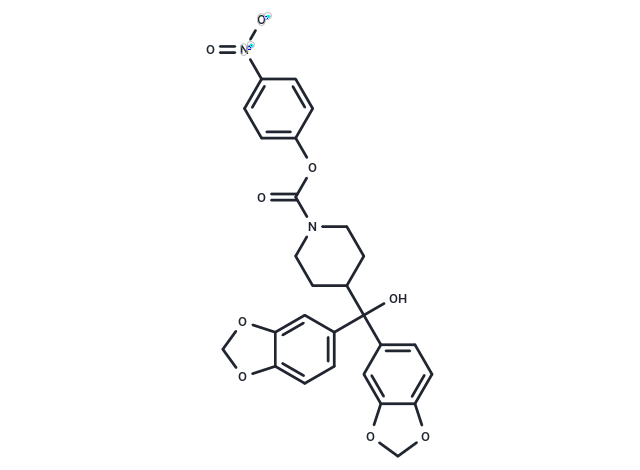Shopping Cart
Remove All Your shopping cart is currently empty
Your shopping cart is currently empty
JZL 184 is a potent and selective inhibitor of MAGL with IC50 of 8 nM and 4 μM for inhibition of MAGL and FAAH in mouse brain membranes respectively.

| Pack Size | Price | USA Warehouse | Global Warehouse | Quantity |
|---|---|---|---|---|
| 5 mg | $34 | In Stock | In Stock | |
| 10 mg | $54 | In Stock | In Stock | |
| 25 mg | $116 | In Stock | In Stock | |
| 50 mg | $219 | In Stock | In Stock | |
| 100 mg | $397 | In Stock | In Stock | |
| 200 mg | $535 | - | In Stock | |
| 1 mL x 10 mM (in DMSO) | $57 | In Stock | In Stock |
| Description | JZL 184 is a potent and selective inhibitor of MAGL with IC50 of 8 nM and 4 μM for inhibition of MAGL and FAAH in mouse brain membranes respectively. |
| Targets&IC50 | MAGL:8 nM |
| In vitro | JZL184 is a useful tool for studying the effects of endogenous 2-AG signaling. JZL184 displays time-dependent inhibition of MAGL and exhibits >300-fold selectivity for MAGL over FAAH in vitro. JZL184 does not interact with CB1 or CB2 receptors and does not inhibit the 2-AG biosynthetic enzymes diacylglycerol lipase-αand diacylglycerol lipase-β, or the arachidonic acid–mobilizing enzyme cytosolic phospholipase A2 group IVA. [1] |
| In vivo | JZL184 produced a rapid and sustained blockade of brain 2-AG hydrolase activity in mice, resulting in eight-fold elevations in endogenous 2-AG levels that are maintained for at least 8 h. JZL184-treated mice showed a wide array of CB1-dependent behavioral effects, including analgesia, hypomotility and hypothermia, that suggest a broad role for 2-AG–mediated endocannabinoid signaling throughout the mammalian nervous system. [1] |
| Kinase Assay | activity-based protein profiling (ABPP): Mouse brains are Dounce-homogenized in PBS, pH7.5, followed by a low-speed spin (1,400×, 5 min) to remove debris. The supernatant is then subjected to centrifugation (64,000×, 45 min) to provide the cytosolic fraction in the supernatant and the membrane fraction as a pellet. The pellet is washed and resuspended in PBS buffer by sonication. Total protein concentration in each fraction is determined using a protein assay kit. Samples are stored at -80 °C until use. Mouse brain membrane proteomes, are diluted to 1 mg/mL in PBS and pre-incubated with varying concentrations of inhibitors (1 nM to 10 mM) for 30 min at 37 °C before the addition of FP-rhodamine at a final concentration of 2 mM in a 50 mL total reaction volume. After 30 min at 25 °C, the reactions are quenched with 4×SDS-PAGE loading buffer, boiled for 5 min at 90 °C, subjected to SDS-PAGE and visualized in-gel using a flatbed fluorescence s |
| Cell Research | 1 × 105 cells are split into four-well chamber slides and incubated with culture medium containing BrdU for 4 h. BrdU staining is performed following the manufacturer's instructions.(Only for Reference) |
| Synonyms | JZL184 |
| Molecular Weight | 520.49 |
| Formula | C27H24N2O9 |
| Cas No. | 1101854-58-3 |
| Smiles | OC(C1CCN(CC1)C(=O)Oc1ccc(cc1)[N+]([O-])=O)(c1ccc2OCOc2c1)c1ccc2OCOc2c1 |
| Relative Density. | 1.467 g/cm3 |
| Storage | Powder: -20°C for 3 years | In solvent: -80°C for 1 year | Shipping with blue ice/Shipping at ambient temperature. | |||||||||||||||||||||||||||||||||||
| Solubility Information | DMSO: 93 mg/mL (178.68 mM), Sonication is recommended. H2O: < 1 mg/mL (insoluble or slightly soluble) Ethanol: < 1 mg/mL (insoluble or slightly soluble) | |||||||||||||||||||||||||||||||||||
| In Vivo Formulation | 10% DMSO+40% PEG300+5% Tween 80+45% Saline: 3.3 mg/mL (6.34 mM), Sonication is recommended. Please add the solvents sequentially, clarifying the solution as much as possible before adding the next one. Dissolve by heating and/or sonication if necessary. Working solution is recommended to be prepared and used immediately. The formulation provided above is for reference purposes only. In vivo formulations may vary and should be modified based on specific experimental conditions. | |||||||||||||||||||||||||||||||||||
Solution Preparation Table | ||||||||||||||||||||||||||||||||||||
DMSO
| ||||||||||||||||||||||||||||||||||||
| Size | Quantity | Unit Price | Amount | Operation |
|---|

Copyright © 2015-2025 TargetMol Chemicals Inc. All Rights Reserved.